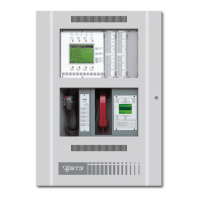Security applications
2.4 EST3 Installation and Service Manual
3-SAC Security Access Control module
The 3-SAC Security Access Control rail module controls a high-
speed RS-485 circuit called the Security Access Control (SAC)
bus. The SAC bus supports fire, security, and access control
devices.
The 3-SAC handles message traffic for these devices, interfacing
them with the CPU as required. Events are passed from the
devices to the 3-SAC module, then to the CPU for alarm
processing.
The 3-SAC has two sets of circuit terminals, and is capable of
Class A or Class B configuration. Each Class B circuit can
include 31 devices, for a total of 62 devices per module. Class A
circuits can include 30 devices total. In the figure, we show a
Class B bus with a KPDISP Keypad Display control and display
module.
SAC bus
Since our security and access control devices require 24 Vdc, we
suggest that you always use a four-wire cable (two twisted-pairs)
for the SAC bus and a 24 Vdc power supply.
For the data wires we suggest unshielded, twisted pair, with
greater than 6 twists per foot, in 14 to 22 AWG (1.50 to 0.25 sq
mm).
For the power wires, we recommend 14 or 16 AWG.
KPDISP Keypad Display
The KPDISP Keypad Display is a control and display module for
security and fire alarm systems. The KPDISP has an LCD
display and a telephone-style keypad. It operates on the 24 Vdc
power supplied with the SAC bus.
The KPDISP is completely menu-driven. It lets the system user:
• Arm and disarm partitions
• Review off-normal points
• Bypass or disable points
• Execute fire alarm panel commands
Each KPDISP stores its portion of the security database.
You can create a security system that is operated via the LCD
module alone, or in combination with any Control/LED display
module. See the topic “Secure access.”
Tip: To improve system
performance in systems
with a high number of
partitions or cardholders,
limit the volume of network
messages. To do this,
create partition routing
groups so that only
essential messages are
sent to each KPDISP. In
practice, limit the average
number of partitions in a
partition routing group to 10
or less.

